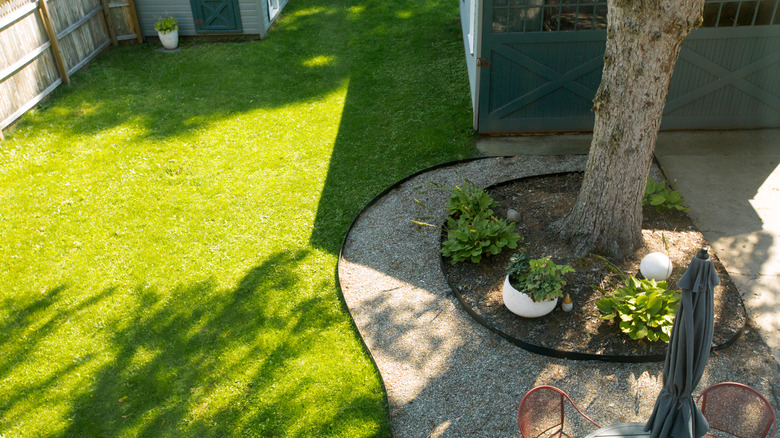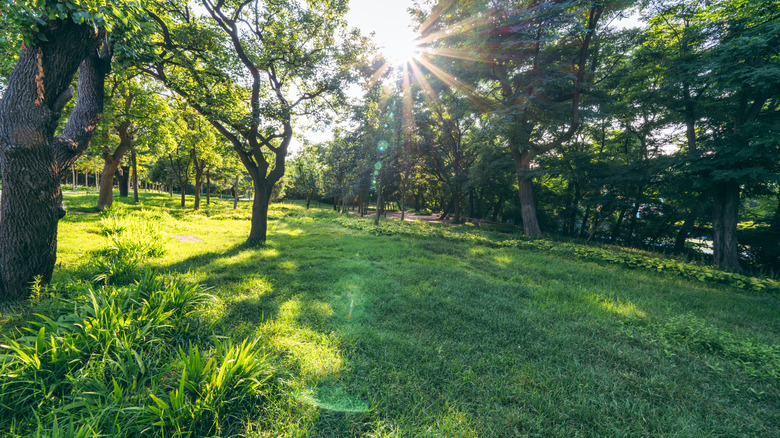Growing A Lush Lawn In Shade Is A Breeze With The Help Of One Must-Know Tip
Most grasses need at least six hours of sun a day to grow into a lush, green yard, but there are a handful of seed varieties that can be nurtured into a blanket of grass in a shady lawn. Grass needs light, water, and nutrients to grow, but so do the trees creating shade. Their deep roots soak up the water and nutrients, while their foliage blocks the sun. Choosing the right type of grass to grow is the first consideration for successfully growing grass in a shady lawn. Certain varieties of fescue (Festuca spp.), alone or combined with roughstalk bluegrass (Poa trivialis), tolerate heavy or partial shade better than bermudagrass (Cynodon dactylon) or buffalograss (Bouteloua dactyloides). Even the most shade-tolerant grasses need four hours of direct sun a day. Consider a groundcover like hummingbird sage (Salvia spathacea) rather than grass if your lawn conditions are unfavorable for turf.
Carefully pruning trees and shrubs that are shading the lawn gives your grass a better chance to succeed. Remove branches on established trees up to about 6 feet off the ground. Shallow feeder roots living just below the soil surface, which compete with the new grass for water and nutrients, can also be removed without harming the tree. Prune bushes when they're dormant to allow for better air circulation and to reduce the humidity that promotes diseases like brown patch and powdery mildew in grass. If the drainage under the trees is poor, reconsider growing grass. Moss thrives in soggy soil, and while it doesn't kill grass, it will fill in bare patches.
The best grasses for shady lawns and how to maintain them
Fescues are cool-season, shade- and drought-tolerant grasses that stay green year-round. Species including hard fescue (Festuca longifolia), sheep fescue (Festuca ovina), and turf-type tall fescue (Festuca arundinacea) tolerate light to moderate shade and dry conditions. The USDA Hardiness Zones vary slightly from species to species, but in general, cool-season grasses prefer daytime temperatures between 65 and 75 degrees Fahrenheit. Cool-season roughstalk bluegrass (Poa trivialis) also grows in shady conditions and prefers wet, poorly-draining soil. It's considered a weed and can go dormant in summer heat, but it usually regrows in the fall. Its coarse texture is a turnoff for some homeowners. Because it spreads so quickly, it's considered invasive in Virginia, Pennsylvania, and Alaska. Kentucky bluegrass (Poa pretensis) is another cool-season grass that does best in dry soil and light shade, and tolerates extreme cold.
St. Augustinegrass (Stenotaphrum secundatum) and zoysiagrass (Zoysia spp.) are the most shade-tolerant warm-season grasses. St. Augustine, hardy in zones 7 through 12, is resistant to weeds and rarely needs mowing. Zoysiagrass grows in zones 5 through 11 and is extremely drought tolerant.
Keep your shady lawn lush with careful fertilization. Apply no more than 2 pounds of nitrogen per 1000 square feet of grass in the fall. Set your mower blade to take off the top inch of grass, and mow when the grass reaches four inches in height. Grass in the shade needs to be watered less frequently to prevent diseases. Don't let fallen leaves accumulate on the lawn.

